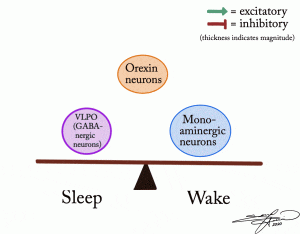-
The mechanisms of narcolepsy can be explained by understanding the roles and relationships of orexin-producing neurons in the brain. Orexin, or hypocretin, is known for regulating arousal, wakefulness, and appetite. As explained visually in the animation, orexin-producing neurons act differentially on various parts of the brain to regulate the states of sleepfulness and wakefulness in a seesaw fashion. When orexin neurons provide excitatory input to monoaminergic neurons, and indirectly suppress GABA-ergic neurons, wakefulness is achieved. When orexin activity decreases, GABA-ergic neurons are more active, and also exert an inhibitory effect on orexin and monoaminergic neurons, and thus a sleep-state is induced. However, the sleep disorder of narcolepsy is characterized by inactive orexin-producing neurons. Without this regulatory neuropeptide, there is no preferential influence on either GABA-ergic or monoaminergic neurons, and so the brain is caught in an unstable alternation between sleepfulness and wakefulness.
Sarrah Hussain
Digital Animation – Autodesk Sketchbook -
A major region of the brain associated with dreaming is the amydala and hippocamus that can be found within the temporal lobe, curving up into the center of the brain.
Viola Yu
Digital Illustration

